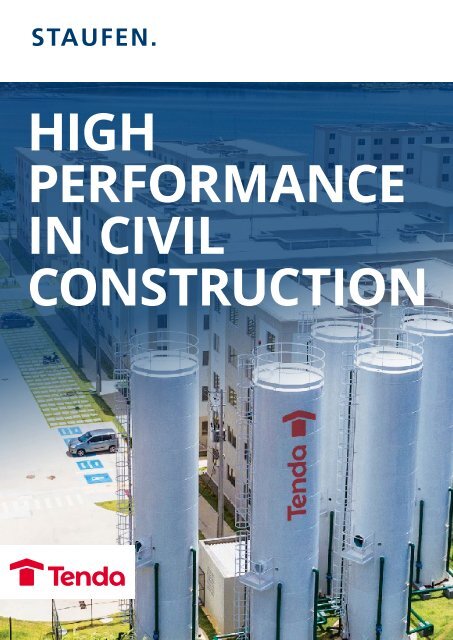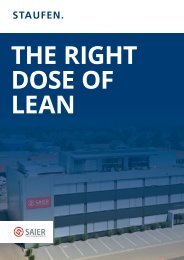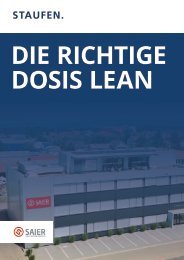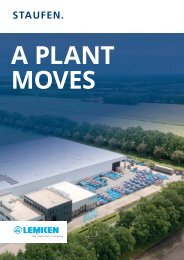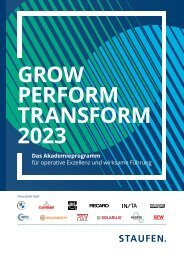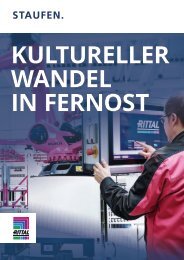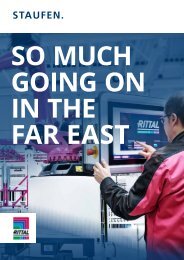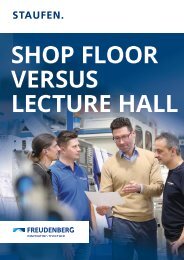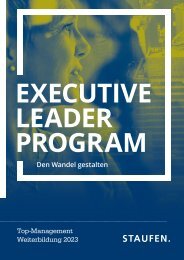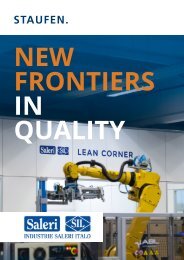Success Story Tenda
High performance in civil contruction
High performance in civil contruction
- No tags were found...
You also want an ePaper? Increase the reach of your titles
YUMPU automatically turns print PDFs into web optimized ePapers that Google loves.
HIGH<br />
PERFORMANCE<br />
IN CIVIL<br />
CONSTRUCTION<br />
STAUFEN. | TENDA – BRAZIL 1
How Construtora <strong>Tenda</strong><br />
leveraged its results by<br />
investing in Lean Thinking<br />
2 STAUFEN. | TENDA – BRAZIL
From groundwork<br />
& restructuring to renewal<br />
<strong>Tenda</strong> was founded in 1969, with the<br />
objective of providing affordable housing<br />
in order that an increasing number of<br />
families could own their first home, and<br />
today it is the second largest construction<br />
and real estate development company in<br />
Brazil, according to the ‘INTEC’ ranking –<br />
Construction Sector Technical Information.<br />
With operations in nine Brazilian states (in the metropolitan regions of São Paulo, Rio de<br />
Janeiro, Rio Grande do Sul, Bahia, Ceará, Goiás, Pernambuco, Paraná and Minas Gerais),<br />
all of the construction company's projects are developed within the Federal Government<br />
Casa Verde e Amarela Project (formerly Minha Casa, Minha Vida), which is aimed at low-income<br />
families.<br />
Goiás<br />
São Paulo<br />
Rio Grande do Sul<br />
Ceará<br />
Pernambuco<br />
Bahia<br />
Minas Gerais<br />
Rio de Janeiro<br />
Paraná<br />
Construtora <strong>Tenda</strong> is<br />
present 9 States across<br />
the country, concentrated<br />
in the metropolitan<br />
regions of São Paulo, Rio<br />
de Janeiro, Bahia, Rio<br />
Grande do Sul, Pernambuco,<br />
Ceará, Paraná,<br />
Goiás e Minas Gerais.<br />
STAUFEN. | TENDA – BRAZIL 3
The beginning of<br />
the Lean Transformation<br />
journey<br />
Construtora <strong>Tenda</strong> has always had strong motivation<br />
for efficiency gains and innovation in its products and<br />
construction processes as a part of its DNA. As one of<br />
the pioneers in Brazil in the construction of masonry<br />
using aluminum molds, <strong>Tenda</strong> already had a foothold<br />
in technological efficiency in construction, however it<br />
was necessary to introduce concepts of efficiency in<br />
management and leadership.<br />
The transformation journey started with the finishing<br />
process - which was carried out by large activity-based<br />
workforces, using teams of external contractors, without<br />
equilibrium, with large quantities of wasted material<br />
and time, leading to extremely high costs for this<br />
stage of the work, in addition to imbalances in progressing<br />
the execution of a building.<br />
This imbalance also signified that the delivery lead<br />
time of the projects was extremely long, leading to<br />
extra costs to ensure the quality and maintenance of<br />
jobsite infrastructure due to the long time delay for<br />
final delivery of the project.<br />
CHALLENGES<br />
ENCOUNTERED<br />
Long delivery<br />
lead times and<br />
low final quality<br />
High rate of<br />
customer<br />
complaints<br />
High costs due<br />
to damage and<br />
wastage of<br />
materials on<br />
site<br />
Loss of<br />
productivity<br />
due to delays<br />
in execution<br />
and the supply<br />
of materials<br />
Large number of<br />
incomplete services<br />
on delivery<br />
4 STAUFEN. | TENDA – BRAZIL
THE<br />
TRANS-<br />
FORMATION<br />
PROCESS<br />
The transformation began at the point where value is<br />
added, where the product is built, and where there is a<br />
direct interface with the end customer, i.e. at the construction<br />
site. It was at the construction site that the<br />
4 principles of process excellence - Free from Disturbances,<br />
One-Piece Flow, Rhythm and Pulled Processes<br />
- were implemented. In order to bring these principles<br />
to civil construction, we created the “LEI” concept:<br />
the flow of Logistics, Execution and Inspection.<br />
WORKS, ENGINEERING<br />
AND SUPPLIES<br />
L<br />
E<br />
I<br />
LOGISTICS<br />
Every day…<br />
Ensure that the required materials/ resourses<br />
are available at the work site<br />
EXECUTION<br />
Every day...<br />
Execute Scheduled Activities<br />
INSPECTION<br />
Every day...<br />
Inspect the Quality of Execution<br />
The production line concept used in industry can be<br />
applied, however in an inverted manner. Whereas in<br />
an industrial process the workstation - with employees,<br />
material and tools - is stationary and the product<br />
flows along the line to the final stage, in Civil Construction<br />
the product (building) is stationary and it is the<br />
workstation - with employees, materials and tools -<br />
which flows through the product. Having applied this<br />
concept, it was possible to define an equilibrium for<br />
work teams based on cycle times and Takt time.<br />
Tower 1 Tower 3 Tower 5 Tower 2 Tower 4 Tower 6<br />
Form 1<br />
Takt time<br />
10 days<br />
Form 2<br />
Takt time<br />
10 days<br />
The concept of standardized product structure was<br />
implemented with the assistance of Product Engineering.<br />
The building with all its subassemblies and components<br />
then becomes the master product, ensuring<br />
standardization in the execution of activities and the<br />
cost of hiring personnel and materials, as well as ensuring<br />
equilibrium in the work team.<br />
During the process of standardizing structures, it was<br />
possible to reduce the number of subsets and components<br />
used, further facilitating the standardization of<br />
operations and employee training.<br />
The just-in-time concept for purchased materials was<br />
also adopted, in order to ensure on-time delivery by<br />
suppliers with the required quantity and quality. This<br />
allowed material inventory at the work site to be reduced,<br />
at the same time reducing shortage of these<br />
materials due to loss, theft and damage.<br />
STAUFEN. | TENDA – BRAZIL 5
OPERATIONAL<br />
LEVERAGE<br />
Logistics<br />
Layout and<br />
supply and<br />
storage<br />
guidelines<br />
Definition and<br />
introduction<br />
of assembly<br />
kits<br />
Internal supply<br />
teams<br />
Regular<br />
Communication<br />
Execution<br />
Balancing<br />
and work<br />
instructions<br />
Flow and setup<br />
between work<br />
sites<br />
Structured<br />
Problem Solving<br />
Regular<br />
Communication<br />
Inspection<br />
Inspection<br />
Checklist<br />
Standard<br />
Appearance<br />
Structured<br />
Problem Solving<br />
Regular<br />
Communication<br />
Engineering<br />
Supply<br />
Product Standardization<br />
Project execution<br />
line<br />
Target supplier<br />
cost<br />
JIT Deliveries<br />
6 STAUFEN. | TENDA – BRAZIL
RESULTS<br />
The transformations initiated in 2014 brought several<br />
positive results for the company which continue<br />
through to the present day, with further improvements<br />
always being sought. Among the principle<br />
problems tackled, the lack of flow of materials at the<br />
work site, imbalance in work teams, high costs with<br />
contractors, problems that persisted project after<br />
project, and the lack of quality in the execution of the<br />
products are among those that had, and continue to<br />
have, the most significant constant improvements.<br />
95%<br />
For over seven years Lean Transformation at Construtora<br />
<strong>Tenda</strong> has accumulated a series of important<br />
results which have an ongoing contribution to the<br />
company's growth, as demonstrated by the following<br />
indicators:<br />
90%<br />
85%<br />
80%<br />
75%<br />
70%<br />
Average improvement in operating<br />
costs of approximately 23%<br />
65%<br />
60%<br />
55%<br />
50%<br />
2012 2013 2014 201 016 2017 201 019<br />
20%<br />
15%<br />
10%<br />
Average EBIT growth of<br />
approximately 9%<br />
5%<br />
0%<br />
-5%<br />
-10%<br />
-15%<br />
-20%<br />
2012 2013 2014 2015 2016 2017 2018 2019<br />
20%<br />
15%<br />
10%<br />
5%<br />
0%<br />
Increase in ROIC (Return On Invested Capital)<br />
of approximately 286%<br />
-5%<br />
-10%<br />
-15%<br />
-20%<br />
2012 201 014 2015 2016 2017 2018 2019<br />
STAUFEN. | TENDA – BRAZIL 7
INTERVIEW<br />
1. In business for over 50 years and with operations<br />
in nine states, today <strong>Tenda</strong> is one of the principle<br />
construction and real estate development companies<br />
in Brazil focused on the affordable housing segment.<br />
With the support of Staufen, the company has been<br />
investing in efficiency and productivity gains to ensure<br />
its deliveries for more than 7 years – optimizing<br />
resources and on-time completion with quality.<br />
As the company's CEO, how do you assess Construtora<br />
<strong>Tenda</strong>'s transformation in recent years to prepare<br />
for this moment, where we are looking at significant<br />
growth?<br />
The company has an “industrial approach” as a strategic<br />
differential within its business model. We were able<br />
to create a virtuous cycle that allowed us to reduce our<br />
costs by more than 30% in this period through continuous<br />
improvement and gains of scale, making us the<br />
player with the lowest execution cost in the market.<br />
As a result, we were able to offer a substantially lower<br />
price than our competitors and were able to serve<br />
lower-income customers, generating increased social<br />
value. Our next step will be to migrate production<br />
from an on-site to an off-site approach, further leveraging<br />
our industrial approach.<br />
Rodrigo Osmo<br />
CEO of Construtora <strong>Tenda</strong><br />
8 STAUFEN. | TENDA – BRAZIL
2. Despite being one of the largest sectors of activity<br />
in the world, Civil Construction is also considered<br />
one of the most inefficient. There is a lot of waste and<br />
a lot of losses in this segment (with materials, equipment,<br />
labor, etc.). How does <strong>Tenda</strong> combat this waste<br />
in order to be able to grow and generate increasingly<br />
robust results?<br />
At the beginning of our journey, we calculated that 60-<br />
70% of the labor component of each apartment built<br />
was wasted. The number seemed impressive, but<br />
those with knowledge of construction sites can identify<br />
this waste everywhere: in unbalanced activities, in<br />
the high waiting times between activities, in periods<br />
when contracted labor are stopped waiting for work<br />
to start, in materials not immediately available for use.<br />
There are several construction systems that can<br />
use an off-site approach: wood frame, steel frame,<br />
cross-laminated timber (CLT), precast concrete. We<br />
chose wood frame for three reasons:<br />
(i) It is cheaper, given the Brazilian supply matrix: Brazil<br />
is the 2nd largest country (behind Russia) in terms<br />
of replanted pine forests (2 million hectares). The market<br />
is pulverized and highly competitive, different to<br />
the oligopoly in steel.<br />
(ii) Eco friendly construction methods: the construction<br />
industry is responsible for 39% of global CO2<br />
emissions. Forests sequester CO2, while cement and<br />
steel emit CO2. In the future companies will invariably<br />
have to adopt more sustainable measures. In our vision,<br />
wood frame technology is the future.<br />
(iii) Superior product, due to its thermoacoustic properties<br />
(wood is a thermal insulator).<br />
We decided to tackle this waste through an industrial<br />
approach, with the assistance of Staufen. We<br />
structure our production so that it has continuity and<br />
rhythm, that is, the same execution team produces<br />
the same number of apartments every day, non-stop,<br />
on different construction sites, similar to a production<br />
line. In doing this we apply several concepts of Lean<br />
Manufacturing across this expansive production line,<br />
eliminating waste and improving processes at each<br />
unit produced.<br />
3. Over the past two years <strong>Tenda</strong> has been announcing<br />
significant investment in research & development<br />
and innovation, in particular with its entry<br />
into the wood frame segment. How did this investment<br />
come about (why wood?) and how should the<br />
company structure its processes going forward? What<br />
are the principle lessons learned in terms of productivity<br />
and efficiency gains which will be fundamental<br />
for this new era?<br />
The great motivator was addressing a limitation in<br />
our ability to continue growing. Current construction<br />
methods require a high minimum local scale of 1,000<br />
units/year in each city where we operate. There are<br />
only 13 cities that can support this scale, and we already<br />
operate in 9 of them. On the other hand, off-site<br />
construction - producing the houses in a manufacturing<br />
environment and only carrying out assembly at<br />
the construction site, would allow us to substantially<br />
increase addressable markets, encompassing the<br />
country’s small and medium-sized cities.<br />
4. <strong>Tenda</strong> recently delivered its first projects using<br />
wood frame technology. What are the expectations<br />
going forward? How much growth does <strong>Tenda</strong> expect<br />
with this market expansion?<br />
We expect to operate on a pilot scale at this learning<br />
stage through 2021 and 2022, and to accelerate production<br />
in 2023. It is a significant challenge: we aim to<br />
reach the production capacity of this first manufacturing<br />
plant of 10,000 units/year in 2026. In terms of<br />
on-site construction, we want to grow 10% to 15% per<br />
year, commencing construction of something close to<br />
30,000 units in 2026. It is an ambitious plan, we commenced<br />
construction of 18,000 units in 2020 and we<br />
are talking about a company with 40,000 units in 2026.<br />
5. There is a lot of talk lately about commitment to<br />
ESG. What is <strong>Tenda</strong>’s position in this regard? Is investment<br />
in wood also linked to sustainability issues?<br />
For a company like <strong>Tenda</strong>, which serves the lowest income<br />
segment of property purchasers, the ESG theme<br />
is close to our heart. We are collaborating in reducing<br />
the country’s housing deficit, building dignified, quality<br />
housing for a public that cannot find alternatives in<br />
the market.<br />
Another aspect in which ESG precepts are present is in<br />
off-site design. We chose to go with wood frame technology,<br />
which uses reforested wood as its principle<br />
component. This element has significant environmental<br />
impact, “sequestering” CO2 from the environment,<br />
unlike traditional construction methods.<br />
STAUFEN. | TENDA – BRAZIL 9
6. Still on the subject of innovation, in recent years<br />
<strong>Tenda</strong> has taken important steps towards the creation<br />
of an organizational culture focused on improvement,<br />
innovation, and above all Digital Transformation. How<br />
was this journey and what has been its impact on the<br />
business?<br />
<strong>Tenda</strong> started digital transformation process in 2018.<br />
Since then we have been able to eliminate many points<br />
of friction with the customer, improving their experience<br />
and contributing to a solid sales volume which<br />
broke records in 2020, despite the pandemic scenario.<br />
We are investing heavily in digital tools and channels:<br />
the rate of customers using our application has more<br />
than doubled from 33% to 72% in the last year, and<br />
development of the management and relationship<br />
platform with sales companies permitted an increase<br />
in 20% to more than 50% in their participation in Company<br />
sales.<br />
7. Talking a little about the affects of the Covid-19<br />
pandemic. What were the main impacts on <strong>Tenda</strong>’s<br />
business, and what decisions have been taken in recent<br />
months to reduce these impacts?<br />
On the other hand, it became clear that we were unable<br />
to function as machines. The negative side of the<br />
excessive efficiency of remote work is the de-personification<br />
of employees. Informal ties were compromised,<br />
we no longer observed the subtleties of facial<br />
expressions, we no longer have relaxed lunches where<br />
we strengthen relationships and reflect on important<br />
topics that are not sufficiently urgent to be on the<br />
agenda of a structured meeting. Additionally, we miss<br />
collective procrastination as a spice for innovation and<br />
creativity.<br />
To be honest, I think that we have yet to find an ideal<br />
balance between the efficiency of remote working and<br />
the importance of personal connections. We are testing<br />
innumerous new work concepts, but we have a lot<br />
of learning ahead.<br />
This year of pandemic has put us in a natural remote<br />
working experience.<br />
On the one hand, we found more efficient ways of<br />
managing our routine. Meetings start and end on<br />
time. We no longer waste time setting up rooms and<br />
projectors that don’t work properly. Full days of travel<br />
have been replaced by 2-hour meetings.<br />
8. As company CEO, how do you assess your role<br />
in leading this company in the face of all these challenges?<br />
And what do you personally look forward to<br />
in the coming years?<br />
The company’s accelerated growth, the need to undergo<br />
a cultural transformation and the stress in personal<br />
relationships arising from this new form of working remotely<br />
(which is here to stay) demand changes in my<br />
way of leading.<br />
Going forward I will focus on providing the correct<br />
context for the company, both in terms of strategic<br />
focus and cultural focus. It will also be important to<br />
ensure that our talent density is constantly growing.<br />
10<br />
STAUFEN. | TENDA – BRAZIL
STAUFEN. | TENDA – BRAZIL 11
ABOUT STAUFEN<br />
Inside every company there is an even better one.<br />
With this conviction, Staufen group has been advising and qualifying<br />
companies and employees since 1994. Around the world.<br />
300<br />
Employees<br />
200<br />
Projects p. a.<br />
PUBLISHER<br />
17<br />
Languages<br />
STAUFEN.Táktica<br />
Consultoria.Academia<br />
Escritório Sede Campinas<br />
Rua Guapuruvu, 180, sala 7 - Alphaville<br />
13098-322 Campinas, SP<br />
Brazil<br />
+55 19 3262 - 0011<br />
Escritório Porto Alegre<br />
Rua Castro Alves, 600 - Independência<br />
90430-130 Porto Alegre, RS<br />
Brazil<br />
+55 51 4042 - 8136<br />
www.staufen.com.br<br />
contato@staufen.com.br<br />
CONTACT:<br />
>65<br />
BestPractice Partners<br />
worldwide<br />
>7.000<br />
Seminar participants p. a.<br />
HEADQUARTERS GERMANY<br />
STAUFEN.AG<br />
Consulting.Academy.Investment<br />
Blumenstraße 5<br />
D-73257 Köngen<br />
+49 7024 8056 0<br />
contact@staufen.ag<br />
www.staufen.ag<br />
Dário Spinola<br />
Managing Director<br />
d.spinola@staufen.com.br<br />
Francisco Cabrera<br />
Senior Expert<br />
f.cabrera@staufen.com.br<br />
Luciana Barros<br />
Marketing Manager<br />
l.barros@staufen.com.br


